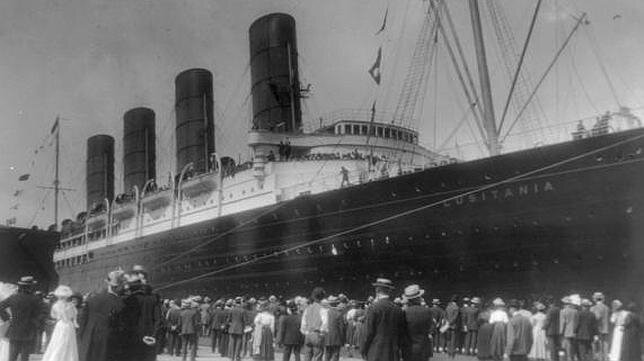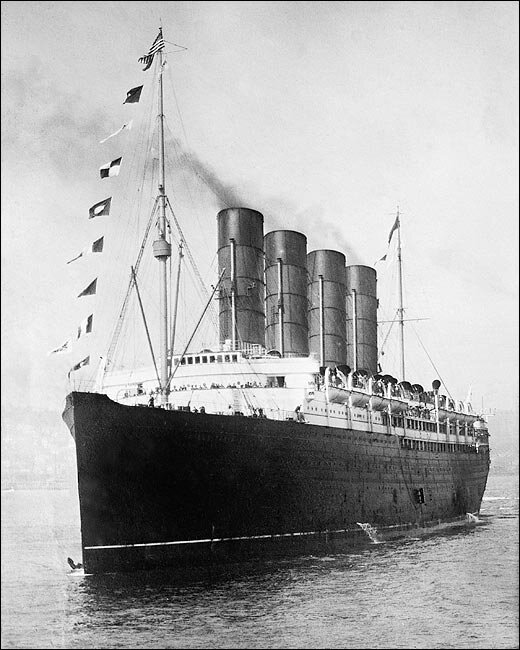Important seed pearl and diamond tiara, Cartier, circa 1909
Lot 498. Important seed pearl and diamond tiara, Cartier, circa 1909. Estimate 500,000 — 700,000 CHF. Lot sold 802,000 CHF. Photo: Sotheby's.
Designed as an open work Greek key band millegrain-set with circular-cut diamonds within an outer border of seed pearls, framing a central detachable old mine-cut diamond, inner circumference approximately 305mm, unsigned, later tiara frame, case stamped Cartier.
Authentification: Designed as an open work Greek key band millegrain-set with circular-cut diamonds within an outer border of seed pearls, framing a central detachable old mine-cut diamond, inner circumference approximately 305mm, unsigned, later tiara frame, case stamped Cartier.
Provenance: Commissioned in 1909 from Cartier Paris by Sir Hugh Montagu Allan for his wife Marguerite Ethel, née Mackenzie, and taken with her on the ill fated final voyage of the RMS Lusitania in 1915. The tiara was with Lady Allan's maids when they were rescued from the shipwreck. Thence by family decent.
Bibliography: Cf.: Geoffrey C. Munn, Tiaras, A History of Splendour, London, 1988, pg. 199, plate 184, for an illustration of a Greek Key patterned tiara of similar design.
Cf.: For additional information about the sinking of the RMS Lusitania please refer to "Robert Paterson Lusitania" a web blog account of the final voyage written by a relative of Lady Allan.
Cf.: www.rmslusitania.info
Note: Sir Hugh Allan commissioned the tiara for his wife Marguerite from Cartier in 1909. He was a Canadian banker and ship owner and was also an avid sportsman who donated the Allan Cup for Canadian amateur ice hockey. After studying at Bishop’s College School in Lennoxville, Quebec and in Paris, France, he joined the family business, the Allan Line, eventually becoming chairman. The Allan Line, known as the Montreal Ocean Steam Ship Company, founded in 1852, operated from Glasgow and Liverpool carrying immigrants to Canada during the early 20th century, until it was taken over by the Canadian Pacific shipping Company in 1909. In 1906 he was created a knight bachelor by King Edward VII and in the following year was decorated Commander of the Royal Victorian Order.
Lady Allan wearing the Cartier's seed pearl and diamond tiara.
In October 1893 he married Marguerite Ethel Mackenzie. They had three daughters and one son, and lived in an imposing 72 room mansion, Ravenscrag, in Montreal, Quebec. Tragically Lady Allan lost both of her daughters, Anna and Gwendolyn in the sinking of the RMS Lusitania and their only son Hugh Allan in the Great War on his first patrol with the Royal Navy Air Service in Belgium in 1917. Their surviving daughter Marguerite Martha, went on to found the “Montreal Repertory Theatre”, although her mother went on to outlive her by 15 years.
In 1915 Lady Allan booked passage on the RMS Lusitania travelling from New York to Liverpool, accompanied by two of her three daughters, Anna Marjory and Gwendolyn Evelyn, two maids: Emily Davis and Annie Walker, and a suite of luggage that included amongst her jewels, the Cartier diamond tiara. She was travelling to Great Britain to organise and open a hospital for Canadian servicemen. The Lusitania began service in 1907, and at the time was the largest and one of the fastest ocean liners in service on the North Atlantic run, frequently taking the Blue Riband from her rivals. At the outbreak of the Great War, although the Lusitania was considered for requisition, it was ruled out due to her size and the risk of U boats that such a large ship would present, as such she was to continue her transatlantic crossings reduced to one a month due to war time economies.
World War I: Lusitania. An advertisement from the New York Herald announcing the sailing of the RMS Lusitania from New York to Liverpool, England, on 1 May 1915. © The Granger Collection/TopFoto
On 4 February 1915, Germany declared the seas around the British Isles a war zone, and that allied ships entering British waters risked attack from German U boats without prior warning. In spite of the risks involved and the Imperial German Embassy of Washington placing a warning below an advertisement for the Lusitania's return voyage on the day of her departure, on 1 May 1915, many felt that the ships speed made her safe. Even without her full capacity the Lusitania could still achieve a speed of 21 knots, 10 knots faster that the German U boats.
The first appearance of the Lusitania at New York Harbour, 13 September 1907 © The Granger Collection/TopFoto
By sheer misfortune at 2.10pm, within sight of the coast of Ireland, the Lusitania crossed in front of the German U-boat U-20, low on fuel and with only three torpedoes left she was ironically preparing to return home. Captain Schwieger gave the order to fire and in spite of his quartermaster’s refusal to attack women and children, action which was later to result in his court-martial and imprisonment, another crewman took over and a single torpedo was launched.
The Lusitania © TopFoto
The torpedo struck just aft the bridge, causing the liner to list as water flooded into the starboard compartments, as the Lusitania sped on at 18 knots, forcing water into her hull and plowing the ship into the sea. The liners precarious list to starboard prevented the passengers safely boarding the starboard boats while the port boats risked being smashed as they dragged on the ships rivets or crashed in on the deck. The chaos was compounded as none of the lifeboats could be safely lowered until the ship slowed which was impossible to achieve as she was no longer responding, the torpedo having knocked out the controls to slow her. Many lifeboats overturned while being loaded and lowered, while others were overturned by the ships motion, of the 48 lifeboats on board only 6 where successfully lowered. Within 6 minutes the Lusitania’s forecastle began to go underwater, and it was a full 10 minutes until the liner had slowed enough to safely start putting the boats in the water. The Lusitania sank in 18 minutes with the loss of 1,198, of the 1,989 passengers on board, including almost 100 children, amongst those the two daughters of Lady Allan. Lady Allan survived the disaster although severely injured with a broken collarbone along with her two maids.
Lady Allan with her two daughters, 1906 © McCord Museum
Although their was international condemnation of the attack in which 128 American citizens lost their lives, America did not declare war on Germany, and in September of 1915 the Kaiser called off unrestricted submarine warfare completely.
Sotheby's. Magnificent Jewels and Noble Jewels, Geneva, 11 nov. 2015, 10:00 AM

/https%3A%2F%2Fprofilepics.canalblog.com%2Fprofilepics%2F1%2F0%2F100183.jpg)
/https%3A%2F%2Fstorage.canalblog.com%2F03%2F02%2F119589%2F96711876_o.jpg)
/https%3A%2F%2Fstorage.canalblog.com%2F11%2F31%2F119589%2F94773502_o.jpg)
/https%3A%2F%2Fstorage.canalblog.com%2F20%2F83%2F119589%2F94772815_o.jpg)
/https%3A%2F%2Fstorage.canalblog.com%2F26%2F72%2F119589%2F75604929_o.jpg)
/https%3A%2F%2Fstorage.canalblog.com%2F59%2F60%2F119589%2F26458628_o.jpg)










/image%2F1371349%2F20240315%2Fob_456a00_f12fdad5-0750-48f5-ae8f-7bd6836745f7.jpg)
/http%3A%2F%2Fstorage.canalblog.com%2F86%2F67%2F119589%2F129815803_o.png)
/http%3A%2F%2Fstorage.canalblog.com%2F40%2F54%2F119589%2F128112000_o.jpg)
/http%3A%2F%2Fstorage.canalblog.com%2F97%2F36%2F119589%2F128062654_o.png)